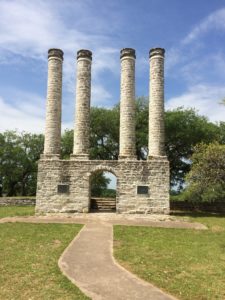
The columns are all that remain of the women’s campus of Baylor University in Independence (Kathy M. Slaughter photo)
Were it not for an act of modesty, and a fateful decision not to welcome a railroad to its hometown, this article would be about Tryon University of Independence, and not Baylor University of Waco.
Three men—Robert E.B. Baylor, James Huckins, and William Milton Tyron, were the key individuals in organizing what today is Baylor University. All were Baptist church leaders. Baylor was a lawyer and judge. Huckins was a church organizer and pastor. Tyron was trained as a tailor but became a minister.
In 1841, while Texas was a republic, they organized an education society in the Texas Union Baptist Association with the goal of establishing a Baptist university in Texas. The Texas Congress issued a charter and the university opened in 1846 in Independence, which today is an unincorporated community north of Brenham.
Baylor and others wanted to name the university in honor of Tyron. They viewed the university as Tyron’s idea. But Tyron said no and suggested the school be named after Baylor instead.
Independence was a good choice for a university location. In its day, Independence was one of the leading communities in Texas. Sam and Margaret Houston lived there for a time because of the educational opportunities there. Eventually the Houstons left but Margaret returned after Sam died in 1863. She died in 1867 and was buried in Independence. Her mother and Sam Houston Jr. are also buried in Independence.
But a variety of factors made keeping the university operational a challenge. One was self-inflicted: community and university leaders decided it didn’t want to grant the Santa Fe railroad a right-of-way through town. People took their business elsewhere.
In 1886, trustees voted to relocate Baylor University to Waco, where it merged with the already-existing Waco University. Baylor has remained an important part of Texas education and Waco community life since.
Baylor hasn’t forgotten its roots, though. Today, two university parks exist in Independence. One is the original site of the campus, when it was a coeducational institution. The second site is to the east, which was organized when officials decided to have separate men’s and women’s institutions. The original site, known as Windmill Hill, is known for the four columns mark the site today. It became the women’s campus. (The women’s campus was moved to Belton and became the University of Mary Hardin-Baylor. Both UMHB and Baylor are coeducational today.) The men’s campus was situated on Academy Hill.
A creek—known in campus folklore as the “River Jordan”—separated the two campuses, and if a young man wanted to have a date with a female student, he must “cross the River Jordan” to pay her a visit.
Baylor freshmen today participate in an orientation session at Independence to learn about the history of their school.
